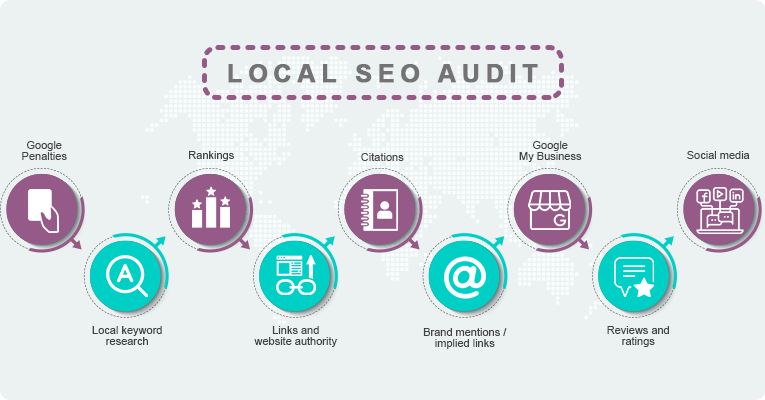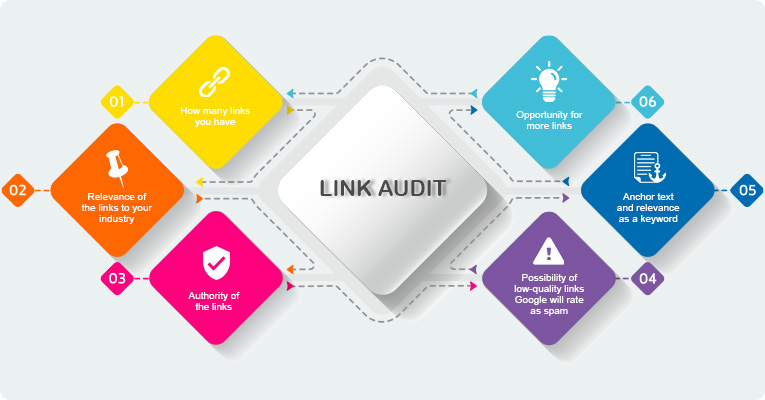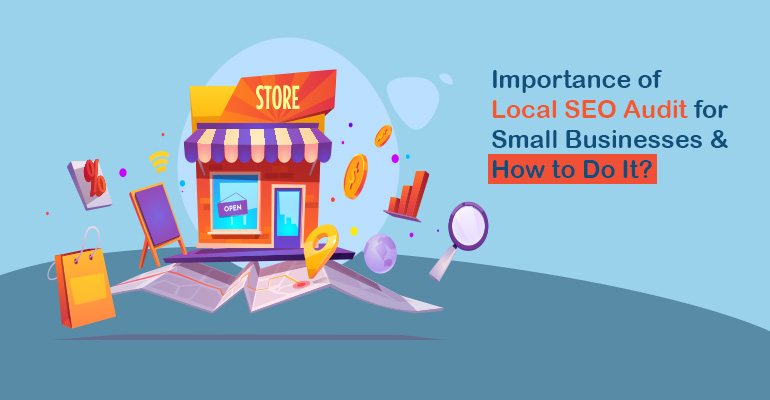Local SEO is your link to local customers. Your brick and mortar location, or even an online business that delivers local services or products needs to be present when potential customers do their “near me” searches. Since 82% of local shoppers conducting near me searches before making a purchase and everyone is walking around town with a smartphone in their hands, you’re always seconds away from someone running the search that will lead them to your door.

You might think you’re all set because you have your website set up and your social media humming, but without local SEO, you’re not making it easy enough for people to find you. Here we look at the importance of local SEO audits and how to do it.
What is a Local SEO Audit?
Local SEO audits make sure you have optimum local presence using every tool at your disposal. It allows you to check your presence and find ways to improve your visibility. When it comes to finding local information, people depend on search engines. Knowing how well your local efforts are doing is key to grabbing their attention. Your audit provides a thorough assessment to make sure the components needed to pack a top ranking are in place.

It improves your local SEO strategy because you’ll know your strengths and weaknesses so you can make sure you are at the top of your game. You’ll also reveal possible issues affecting your ranking such as penalties due to questionable SEO tactics. Many companies don’t even realize this is something suppressing their rankings. Your audit includes:
- Google Penalties
- Local keyword research
- Rankings
- Links and website authority
- Citations
- Brand mentions / implied links
- Google My Business
- Reviews and ratings
- Social media
So all your bases are covered.
What is the Focus of Local SEO Audit?
You want to focus on three things:
- Proximity: How close are you to your ideal search user?
- Prominence: How high profile is your site?
- Relevance: How relevant is your page to the terms and keywords your ideal customers will make?
These three areas help establish how your SEO strategy is working to help attract local customers to your business based on your location, how you use it and the information on your website that helps establish your relevance to make you more prominent in your rankings. These three pillars ensure Google finds you have everything needed to raise you higher in the rankings to meet the needs of their users. You’ll get a clear picture of where you stand, so you can improve your strategy.
Steps to Perform Your Audit
Now that you have an idea of the basics, you can follow these steps to perform your audit:
Address Google Penalties
Google penalties are applied when Google finds you fail to comply with their quality guidelines. You might have penalties for doing something you didn’t even realize was bad, and are paying the price with lost rankings. In other cases, you might have used an SEO or web service that did something they shouldn’t and again are paying the price.
Also, as Google introduces new algorithms you might be doing something that was acceptable, but they don’t like now. You can check for manual penalties via Google Search Console, under ‘Messages’. The notice will tell you why they penalized you, the pages in question and what you can do to fix it. You then have to submit a reconsideration request so Google can check to make sure you are following their best practices.
Issues include things like spam, unnatural links, thin content, and mobile redirects. If there aren’t any messages and your rankings have dipped, it could be your SEO efforts aren’t working with an algorithm update. In this case, assess your content and make improvements to make sure it is high quality, original and up to date.
Local Keyword Research
Unfortunately, keyword research never ends. It has to remain up to date with search trends to meet the search criteria your target is using. Your audit considers local keywords so you can introduce better keywords that optimize local searches. You might be using industry terms for example, instead of the words customers use. You might have forgotten to include new products or services.
Local keyword research will update your keywords so you can include relevant keywords that anticipate customer needs. A handy tool is Google Trends to identify opportunities to improve your SEO strategy and keep ahead of competitors who have gotten lazy with their keyword updates. You can then add your subset of geo-modified keywords.
Audit Rankings
Your audit rankings show how you’re doing so you can identify areas you need to improve performance. You will have to consider your SEO strategy as well as how your competitors are outdoing you. There are tools available to help you find opportunities to improve SEO so you can outrank your competitors. You can understand metrics you can use as benchmarks to follow your progress for certain keywords, so you have a better idea if your updates are working.
Audit Links

Hopefully, you’ve incorporated links into your site both to authoritative websites (outbound links) as well as from authoritative sites to your own (inbound links). This is a very important element of SEO that many small businesses overlook. Google considers links when searching the top sites they rank. This is because links to sites of authority help establish relevance and prominence. These are important elements of organic rankings. Your link audit looks at:
- How many links you have
- Relevance of the links to your industry
- Authority of the links
- Possibility of low-quality links Google will rate as spam
- Anchor text and relevance as a keyword
- Opportunity for more links
Backlinks are necessary as they help establish you within your ideal niche. Keep in mind that you’ll be in the awkward position to request low-quality links remove your site links.
Verify Google My Business
Google My Business listings are at the heart of your local SEO efforts. It is the basis for your Google name, address, phone number (NAP) and provides the basics both customers and Google need to find you. Not only do you need to make sure Google My Business is up to date, but also that you understand any new features Google provides that you should be using. Your goal is to set up your account so that you follow Google’s best practices and keep your listing up to date.
Take advantage of everything Google offers including images, your business description, NAP, keywords opportunities, the category and sub-category, etc. This will ensure you are visible in your local pack. Verify your listing, claim the short URL and activate the booking button if it applies to your services. You can also be sure you review analytics, so you see how you are doing. Don’t forget to:
- Verify you are still monitoring the public email address
- Ensure you are using the Question and Answers feature
- Upload videos
Last but not least compare your profile to your competitors and try to improve your efforts to outdo them.
Look at Citations
This is not as important but still has its place in local SEO. You need to look at:
- Accurate NAP on each listing site you appear
- Consistency of the NAP for every single citation
- Duplicate listings that differ for addresses on one listing that confuse customers trying to find you
The bottom line is customers tend to mistrust companies that have conflicting information as it is inconvenient and frustrates them during their searches. Your goal is to choose one address form including little details such as Avenue vs Ave or even Ave. and make sure it is consistent across all citations. One of the easiest ways to avoid conflicting citations is to first make sure your Google My Business address is correct as listing sites use that address to establish their listings.
Investigate Brand Mentions and Implied Links
Implied links and brand mentions are necessary because they provide references or mentions on other relevant sites without links. When a site uses your brand in a situation such as “according to brand X” it indicates the site sources feel you are knowledgeable enough to be mentioned as an authority to the info they provide.
The beauty of these mentions is that they are less likely to have spurious spammy links. Some might even say mentions are better than links. You can do this part of the audit by searching your business name in quotes. This will show you the sites where you are mentioned. A mention that includes your NAP becomes an implied link.
Keep Up with Reviews and Ratings
Never underestimate the importance of online reviews and ratings. This is the go-to most consumers search to make a decision on whether or not they can trust you. Reputation management is one of the most important elements of your local SEO audit as you need to understand how customers view your products and service.
This is the quickest ways to establish trust, and you should encourage customers to make reviews or to rate your service. Check the most popular and relevant review sites and see what your average rating is. Those stars are the first thing most customers see when doing a search. Understanding how people view you, and more importantly the stars they’ll see. You know how powerful those stars are based on your own personal searches. Anything under three or even four stars stand out like a soar thumb. Look at any comments or questions made that you didn’t answer as the longer you take to respond or even comment back with a word of thanks to positive reviews, the worse you look.
Your audit allows you to improve your service because you’ll see where you are missing the mark. It might be customer service attitude, it could be slow delivery, it could be product quality, etc. Use negative comments to get better at what you do from every aspect of your business. Never have staff or others post fake reviews to try to improve your rating. Also, look for possible negative fake reviews competitors might post to try to bring your rating down. Don’t forget to set up profiles on the logical industry review sites so you have more opportunities to improve your ranking and reviews.
Don’t Forget Social Media
Make sure you have active social media accounts for the channels that make sense for your business. A very creative business or fashionable business might not need a LinkedIn account while a professional office would for example. Verify all bios, usernames and logos are consistent and make sure you update your profile as needed, make regular posts and answer questions. See where your competitors are using social media and make sure you are keeping up with their efforts, or better yet, outdoing them with engagements.
Let’s check out these social media marketing stats by Sprout Social.
- Globally, over 3.6 billion people use social media and the number is only projected to increase to 4.41 billion in 2025.
- Internet users spend an average of 144 minutes on social media per day.
- 57% of consumers will follow a brand to learn about new products or services while 47% will follow to stay up to date on company news.
- After following a brand on social media, consumers continue to engage in various ways. Ninety-one percent visit the brand’s website or app, 89% will buy from the brand and 85% will recommend the brand to a family or friend.
- The top four reasons consumers will unfollow a brand on social media are poor quality of product or support (49%), poor customer service (49%), irrelevant content (45%) and too many ads (45%).
Following these steps takes a lot of time and effort, but it is well worth it to improve your local SEO strategy. Let us do the heavy lifting when it comes to your local SEO strategy. Contact our team for a free discovery call today.
